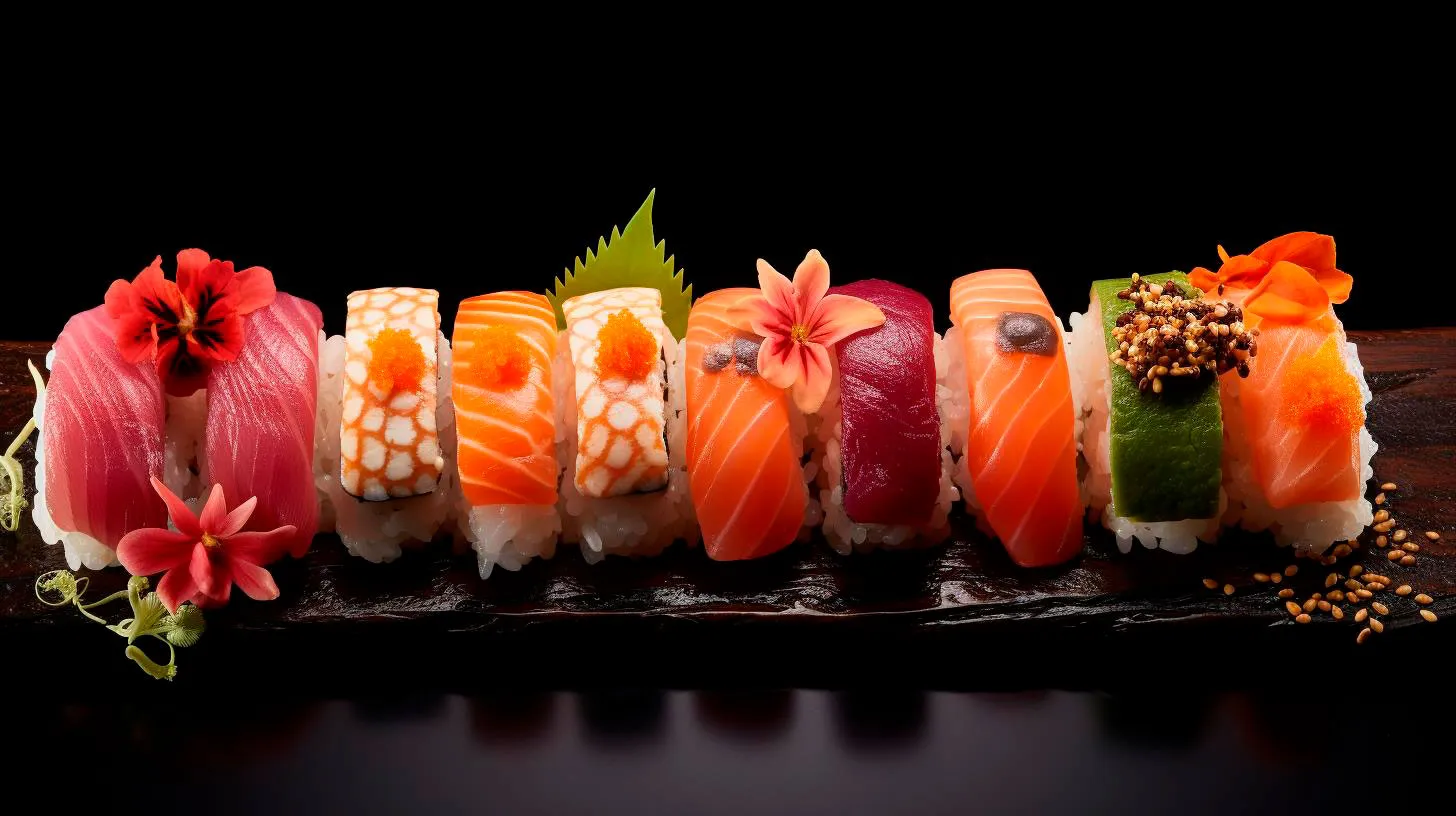The Future of Sushi Rice Vinegar: Modern Trends and Adaptations
In this article, we will explore the future of sushi rice vinegar, the modern trends surrounding it, and how it is being adapted to cater to changing consumer preferences.
The Rise of Sushi’s Popularity
Sushi has come a long way from its origins in Japan. Today, it has become a global sensation, with sushi restaurants popping up in every corner of the world. According to a market research report, the global sushi market is expected to reach a value of $22.64 billion by 2025, growing at a CAGR of 4.1% from 2019 to 2025. This increasing popularity of sushi has also led to a surge in the demand for sushi rice vinegar.
Modern Trends in Sushi Rice Vinegar
1. Organic and Natural Ingredients
In recent years, there has been a significant shift towards healthier and more sustainable food options. This trend has influenced the sushi industry as well, including the ingredients used to make sushi rice vinegar. Consumers are now seeking sushi rice vinegar made from organic and natural ingredients, free from artificial additives and preservatives. This shift towards healthier options has encouraged producers to develop organic versions of sushi rice vinegar to meet the growing demand.
2. Reduced Sugar and Sodium Content
As people become more health-conscious, they are paying closer attention to the nutritional content of their food. Traditional sushi rice vinegar often contains high levels of sugar and sodium, which can be detrimental to health when consumed in excess. In response to this, some producers are now offering low-sugar and low-sodium options of sushi rice vinegar, providing a healthier alternative without compromising on taste.
3. Artisanal and Small-Batch Production
Just like in the craft beer and coffee industry, consumers are increasingly interested in artisanal and small-batch food products. This trend has made its way into the sushi rice vinegar industry as well. Some producers are focusing on handcrafted sushi rice vinegar, made in small batches using traditional methods. This approach not only adds a touch of authenticity to the product but also allows for better quality control and attention to detail.
Key Advantages of Modern Adaptations
The modern adaptations in sushi rice vinegar bring several advantages to both producers and consumers:
- Healthier Options: Reduced sugar and sodium content in sushi rice vinegar provide a healthier choice for health-conscious individuals.
- Increased Variety: The availability of organic and natural sushi rice vinegar offers consumers a wider range of options to suit their dietary preferences.
- Enhanced Taste: Despite the reduced sugar and sodium content, modern sushi rice vinegars are crafted to maintain the delicious tangy flavor, ensuring an enjoyable sushi experience.
- Support for Local Producers: The focus on artisanal and small-batch production not only offers unique flavor profiles but also supports local producers and promotes sustainability.
Innovation in Sushi Rice Vinegar
The future of sushi rice vinegar looks promising, with ongoing innovations in the industry:
- Flavored Varieties: Some producers are experimenting with flavored versions of sushi rice vinegar, such as ginger-infused or yuzu-flavored options, to add an extra layer of complexity to sushi dishes.
- Sustainable Packaging: As sustainability becomes a priority, some companies are exploring eco-friendly packaging options for their sushi rice vinegar products, such as recyclable bottles or pouches.
- Enhanced Shelf Life: Researchers are working on developing techniques to extend the shelf life of sushi rice vinegar without compromising its quality, ensuring a longer product lifespan and reducing waste.
Conclusion
The future of sushi rice vinegar is bright, with the industry adapting to modern trends and consumer demands. From organic and natural ingredients to reduced sugar and sodium content, the innovations in sushi rice vinegar cater to the growing health-conscious population. Artisanal production methods and flavored varieties add a distinct touch to this essential sushi ingredient. With sustained growth in the sushi market, the demand for sushi rice vinegar is set to rise, providing ample opportunities for further innovation and development.
Innovative Flavors Transforming Sushi Rice Vinegar
Traditionally, sushi rice vinegar has been a simple mixture of rice vinegar, sugar, and salt. However, in recent years, there has been an explosion of innovative flavors that are transforming this humble ingredient, taking sushi to new heights. In this article, we will explore the exciting world of flavored sushi rice vinegar and discuss how it is revolutionizing the sushi experience.
Flavored Sushi Rice Vinegar: Breaking Tradition
As sushi gained popularity globally, chefs and food enthusiasts began experimenting with various flavors to enhance the overall taste experience. This experimentation led to the creation of flavored sushi rice vinegars that add an extra layer of complexity to the traditional sushi preparation process.
Here are some key takeaways on the benefits and features of flavored sushi rice vinegar:
- Enhanced Taste: Flavored sushi rice vinegars add depth and complexity to the rice, elevating the overall flavor profile of the sushi roll.
- Creative Combinations: These innovative vinegars come in a wide variety of flavors, allowing chefs to experiment and create unique sushi creations.
- Easy to Use: Flavored sushi rice vinegars can be used in the same way as traditional vinegar, making it convenient for both professional chefs and home cooks.
- Time-Saving: With flavored sushi rice vinegar, chefs can skip the step of seasoning the rice, as the vinegar already contains the perfect balance of flavors.
Exploring Flavorful Possibilities
The world of flavored sushi rice vinegar offers a diverse range of tantalizing options, allowing sushi enthusiasts to explore new and exciting flavors. Here are some popular flavored sushi rice vinegars:
Wasabi Infused Sushi Rice Vinegar
Wasabi lovers rejoice! Wasabi-infused sushi rice vinegar combines the unmistakable heat of wasabi with the tanginess of vinegar, resulting in a delightful kick that enhances sushi rolls. Perfect for those who enjoy a spicy twist to their sushi experience.
Mango and Ginger Sushi Rice Vinegar
For a fruity and refreshing twist, mango and ginger sushi rice vinegar infuses the rice with the tropical sweetness of mango and the earthy, spicy notes of ginger. This combination adds brightness and complexity to sushi rolls, especially those with seafood fillings.
Matcha Sushi Rice Vinegar
Matcha, the finely ground green tea powder, has been gaining popularity due to its unique flavor and health benefits. Matcha sushi rice vinegar combines the earthiness of matcha with the tanginess of vinegar, resulting in a vibrant, umami-rich flavor that complements a variety of sushi ingredients.
The Future of Sushi Rice Vinegar
The introduction of flavored sushi rice vinegar has revolutionized the sushi industry, inspiring chefs to push the boundaries of traditional sushi flavors. As more and more people discover the exciting possibilities of these innovative vinegars, it is expected that the trend will continue to grow.
Key Takeaways:
- Flavored sushi rice vinegar adds complexity and depth to sushi rolls.
- Various flavors of vinegar allow for creative and unique sushi creations.
- Convenient and time-saving, as rice seasoning is no longer necessary.
- Popular flavors include wasabi, mango and ginger, and matcha.
- The trend of flavored sushi rice vinegar is expected to continue growing in the future.
As sushi evolves and adapts to global tastes, flavored sushi rice vinegar stands out as a game-changer in the culinary world. With its ability to elevate flavors and unleash creative possibilities, it’s no wonder that sushi lovers around the world are embracing the innovative flavors that are transforming sushi rice vinegar.
Traditional Techniques for Brewing Sushi Rice Vinegar
In this article, we will delve into the traditional techniques used to brew sushi rice vinegar and why it is worth exploring this ancient process.
The Art of Brewing Sushi Rice Vinegar
For centuries, Japanese artisans have been refining the craft of brewing sushi rice vinegar. The process starts with a simple blend of rice, water, and a unique strain of bacteria called “Acetobacter.” This bacteria converts the rice’s natural sugars into alcohol and further ferment them into acetic acid, the main component of vinegar. Traditional methods are still revered today for their ability to produce exquisite and authentic sushi rice vinegar.
The key steps involved in brewing sushi rice vinegar include:
- Rice Washing and Steaming: High-quality Japanese rice is thoroughly washed to remove any impurities and excess starch. Then, the rice is steamed to a perfect texture, ensuring it will provide an ideal base for vinegar fermentation.
- Vinegar Seed Preparation: A small portion of previously brewed vinegar mixed with sake or mirin is added to the steamed rice, acting as a “seed” to introduce the Acetobacter, kick-starting the fermentation process.
- Fermentation and Aging: The mixture is then left to ferment in a cool environment for several weeks. During this period, the Acetobacter converts the alcohol into acetic acid. Traditional brewmasters pay close attention to temperature and environmental factors to achieve the desired balance of flavor and acidity.
- Maturation: After fermentation, the vinegar is aged in wooden barrels or vats, allowing it to develop a rich and complex flavor profile. This maturation process can range from a few months to several years.
- Filtering and Bottling: Finally, the vinegar is carefully filtered to remove any sediment before being bottled for sale or use in sushi restaurants.
The Advantages of Traditional Brewing Techniques
While modern vinegar production methods have evolved to meet rising demand, traditional brewing techniques still hold numerous advantages:
- Authentic taste: Traditional brewing methods create a unique taste profile with a delicate balance of sweetness and acidity, enhancing the overall flavor of sushi rice.
- Complex and subtle flavors: The slow fermentation and maturation process in wooden barrels allow the vinegar to develop complex flavors, enhancing its compatibility with a wide range of sushi ingredients.
- Preservation of nutritional value: Traditional brewing techniques prioritize preserving the nutritional value of the rice vinegar, resulting in a healthier final product.
- Environmental sustainability: Wooden barrels and vats are eco-friendly alternatives to plastic, contributing to a more sustainable brewing process.
Key Takeaways
Brewing sushi rice vinegar using traditional techniques is an art form rooted in Japanese culture. By following the age-old method, artisans achieve a unique taste, rich in subtlety and complexity. For sushi enthusiasts and connoisseurs, exploring traditional sushi rice vinegar can elevate your dining experience to a whole new level. Remember these key takeaways:
- Traditional brewing techniques involve rice washing, fermentation, maturation, and aging.
- Traditional methods offer an authentic taste and complex flavor profile.
- These techniques preserve the nutritional value of rice vinegar and contribute to environmental sustainability.
So, the next time you savor a delicious piece of sushi, take a moment to appreciate the beauty of traditional brewing techniques that contribute to the incredible flavor of sushi rice vinegar. Embrace the artistry and tradition behind this essential ingredient, and elevate your sushi experience to new heights.
The Origins of Sushi Rice Vinegar
In this article, we will delve into the origins of sushi rice vinegar, its significance in Japanese cooking, and the process of making this essential ingredient.
The Significance of Sushi Rice Vinegar
Sushi rice vinegar, also known as “su” or “sushi-zu” in Japanese, is a type of vinegar used in the preparation of sushi rice. It is made by blending rice vinegar, sugar, and salt, creating a sweet and tangy flavor that perfectly complements the other components of sushi. Sushi rice vinegar not only enhances the taste of the rice but also acts as a preserving agent, preventing the rice from spoiling and extending its shelf life.
When sushi was first invented in Japan, around the 8th century, sushi rice vinegar played a vital role in the preservation of fish. This was especially crucial because refrigeration did not exist at that time. The natural acidity of the vinegar helped to kill bacteria and parasites, making sushi safe to consume.
The Origins of Sushi Rice Vinegar
The origins of sushi rice vinegar can be traced back to ancient China. The Chinese were the first to develop rice vinegar as a way to preserve rice and other food items. As the art of sushi-making migrated from China to Japan, so did the use of rice vinegar in sushi preparation. The Japanese quickly recognized the benefits of using vinegar in their sushi rice, both for flavor enhancement and preservation.
It is interesting to note that in the early days of sushi-making, rice vinegar was not readily available in Japan. Instead, they had to make vinegar from scratch using the traditional fermentation process. Initially, the primary ingredient used was sake, a rice wine. Over time, rice vinegar became more accessible, and the traditional fermentation process was replaced by commercially produced vinegar.
The Making of Sushi Rice Vinegar
To make sushi rice vinegar, the process begins with rice vinegar, which is made from fermented rice. The vinegar is then mixed with sugar and salt to achieve the desired balance of flavors. The proportions may vary depending on personal preferences and regional variations, such as the use of Mirin, a sweet rice wine, in some recipes.
Commercially produced sushi rice vinegar typically undergoes pasteurization to enhance its shelf life. However, some traditionalists argue that pasteurization alters the flavor and opt for unpasteurized versions.
Key Takeaways
- Sushi rice vinegar is an essential ingredient in sushi preparation, enhancing the flavor and preserving the rice.
- The origins of sushi rice vinegar can be traced back to ancient China, where rice vinegar was used for rice preservation.
- The Japanese adopted the use of rice vinegar in sushi-making from the Chinese.
- In the early days of sushi-making, vinegar was made from scratch using the traditional fermentation process.
- Commercially produced sushi rice vinegar undergoes pasteurization to prolong its shelf life.
Sushi rice vinegar holds a significant role in the creation of authentic sushi. Understanding its origins, significance, and production process helps us appreciate the artistry and time-honored traditions behind this integral ingredient. The next time you savor a piece of sushi, take a moment to appreciate the subtle flavors that sushi rice vinegar brings to this exquisite dish.



